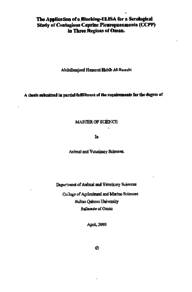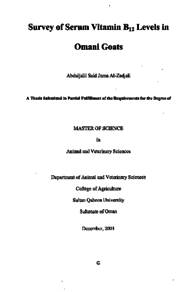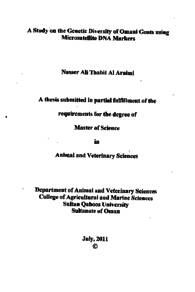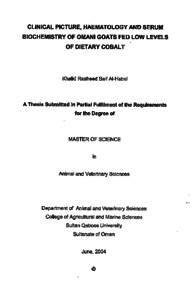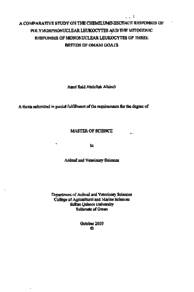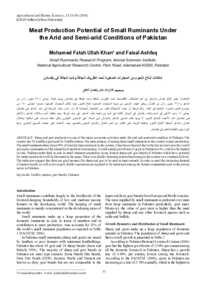Document
The application of a blocking-ELISA for a serological study of contagious caprine pleuropneumonia (CCPP) in three regions of Oman
Publisher
Sultan Qaboos University
Gregorian
2003
Language
English
Subject
English abstract
Contagious Caprine Pleuropneumomonia (CCPP) is a severe disease affecting goats in Eastern Africa and the Middle East, caused by the Mycoplasma capricolum subsp. capripneumonia (Mccp). It was previously classified as a member of so-called mycoplasma mycoides cluster and termed as (F38 group). CCPP has been described as the most serious devastating infectious disease of goats in the Sultanate. It is characterized clinically by fever (41-43 °C) and severe respiratory manifestations. The morbidity rate may reach up to 100 % and mortality up to 70% when no control measures are taken. The diagnosis of the disease by means of characterization of the clinical signs is difficult, as many diseases have similar clinical manifestation. Diagnosis of CCPP on the basis of isolation and identification of the causative agent is also difficult, as the pneumonic lesions are often mixed with other pathogens. Many serological tests have been used to evaluate the antibody status of affected goats, however, the specificity of these tests is usually poor as they detect antibodies against antigens of mycoplasma which are shared by other species of the mycoides cluster. Hence the interpretation of the results is often difficult.
A blocking ELISA (B-ELISA) is a new diagnostic tool that was designed for the specific detection of antibodies developed against Mccp in serum of infected goats. It is reported to be highly specific and sufficiently sensitive. In this study, B-ELISA was utilized to evaluate the presence of Mccp-antibodies in 535 serum samples collected from both vaccinated and non vaccinated animals (495 from nonvaccinated animals from Barka, Nizwa and Bahla and 40 samples from vaccinated Batina female animals from Sohar). Goats were selected from various age groups, sexes and breeds from three regions of the Sultanate. The results demonstrated that 47 % of non-vaccinated animals were seropositive for Mccp. There were no significant differences due to age, sex, breed or the three regions. These results are indicative of the widespread presence of Mccp in the Sultanate. Vaccinated animals showed a similar (P>0.05) percentage (50 %) of seropositive cases, suggesting either an inability of the B-ELISA to differentiate between the non-vaccinated and vaccinated animals or that the epitope employed in the B-ELISA is not expressed in the vaccine or that there was vaccination failure.
Member of
Resource URL
Arabic abstract
مرض الالتهاب الرئوي البلوري المعدي مرض شديد الإصابة يصيب الماعز ، ويتواجد في شرق افريقيا والشرق الأوسط تسببه ميكوبلازما تسمى Mycoplasma capricolum subsp. Capripneumonia قسمت مع مجموعة ما يسمى ( mycoplasma mycoides cluster ) وكانت تعرف ب (F38 group )، وصف المرض على أنه من أشد الأمراض المعدية التي تصيب الماعز في السلطنة ويتميز إكلينيكيا بارتفاع درجة الحرارة ("c 43- 41) واعراض تنفسية، ويمكن أن تصل نسبة الإصابة في القطيع الواحد إلى 100 % مخلفا نسبة نفوق قد تصل إلى 70 % إذا لم يتم معالجة الحيوانات المصابة مبكرا.
حقليا هناك صعوبة في تشخيص المرض من الأعراض الإكلينيكية كون أعراضه تتشابه مع الأعراض الإكلينيكية لأمراض أخرى ، ومع أن الأمراض المعدية يتم تشخيصها عادة بواسطة عزل وتصنيف المسببات إلا أن ذلك لا يمكن عمله مع مسبب هذا المرض کون الإصابات الرئوية تكون عادة مليئة بأكثر من مسبب. لذلك فإن العديد من الاختبارات السيرولوجية تم استخدامها لتقييم الردود المناعية لهذا المرض ولكن وللأسف فإن النتائج المستخلصة منها لا يمكن التعويل عليها كونها لا تتميز بما يسمى بالتخصصية المطلقة ( Specificity ) حيث أنها يمكن أن تكشف عن وجود أجسام مضادة ناتجة عن مسببات ميكوبلازمية أخرى غير المسبب لهذا المرض خصوصا تلك التي تنتمي إلى ما يسمى ب (mycoplasma mycoides cluster ). الى ( B- ELISA ) هو فحص مختبري جديد مصمم خصيصا لكشف الأجسام المضادة في مصل الحيوان المصاب ويتميز بدرجة عالية من الحساسية لذا فإنه يمكن أن تميز بين الحيوان المتعرض لمسبب هذا المرض (Mccp ) وبين تلك المتعرض المسببات الأخرى المنتمية إلى ( mycoide cluster ) وبالتالي فإن هذه الدراسة استخدمت هذه التقنية الجديدة لتقييم الأجسام المناعية لهذا المرض في الماعز العماني ، حيث تم تجميع 535 عينة من ثلاث مناطق في السلطنة هي بركاء- نزوی - بهلا من حيوانات محصنة وغير محصنة ومن سلالات مختلفة باعمار مختلفة وأجناس مختلفة .
وقد أظهرت النتائج أن نسبة الحيوانات التي يمكن أن تقسم إلى حيوانات مصابة سيرولوجيا بلغت 47. 7 % . وأنه لا يوجد فروق معنوية بين نسبة الإصابة في الذكور والإناث ولا بين السلالات المختلفة ( الباطنة، الجبل الأخضر، والظفاري). كذلك فإن نسبة الإصابة لم تختلف بين منطقة وأخرى ولم تختلف باختلاف الأعمار بين الحيوانات مما يعني أن نسبة عالية من الماعز في السلطنة قد تعرضت لمسبب المرض عند مختلف الأعمار ومختلف السلالات ومختلف الأجناس. إن عدم وجود أي اختلاف في الردود المناعية للحيوانات المحصنة والغير محصنة كما أظهرت الدراسة قد يعني عدم استطاعة التقنية المستخدمة للتفريق بين الحيوانات المحصنة والمصابة أو أن ذلك قد يعني أن برنامج التحصين لم يعمل بالكفاءة المطلوبة.
حقليا هناك صعوبة في تشخيص المرض من الأعراض الإكلينيكية كون أعراضه تتشابه مع الأعراض الإكلينيكية لأمراض أخرى ، ومع أن الأمراض المعدية يتم تشخيصها عادة بواسطة عزل وتصنيف المسببات إلا أن ذلك لا يمكن عمله مع مسبب هذا المرض کون الإصابات الرئوية تكون عادة مليئة بأكثر من مسبب. لذلك فإن العديد من الاختبارات السيرولوجية تم استخدامها لتقييم الردود المناعية لهذا المرض ولكن وللأسف فإن النتائج المستخلصة منها لا يمكن التعويل عليها كونها لا تتميز بما يسمى بالتخصصية المطلقة ( Specificity ) حيث أنها يمكن أن تكشف عن وجود أجسام مضادة ناتجة عن مسببات ميكوبلازمية أخرى غير المسبب لهذا المرض خصوصا تلك التي تنتمي إلى ما يسمى ب (mycoplasma mycoides cluster ). الى ( B- ELISA ) هو فحص مختبري جديد مصمم خصيصا لكشف الأجسام المضادة في مصل الحيوان المصاب ويتميز بدرجة عالية من الحساسية لذا فإنه يمكن أن تميز بين الحيوان المتعرض لمسبب هذا المرض (Mccp ) وبين تلك المتعرض المسببات الأخرى المنتمية إلى ( mycoide cluster ) وبالتالي فإن هذه الدراسة استخدمت هذه التقنية الجديدة لتقييم الأجسام المناعية لهذا المرض في الماعز العماني ، حيث تم تجميع 535 عينة من ثلاث مناطق في السلطنة هي بركاء- نزوی - بهلا من حيوانات محصنة وغير محصنة ومن سلالات مختلفة باعمار مختلفة وأجناس مختلفة .
وقد أظهرت النتائج أن نسبة الحيوانات التي يمكن أن تقسم إلى حيوانات مصابة سيرولوجيا بلغت 47. 7 % . وأنه لا يوجد فروق معنوية بين نسبة الإصابة في الذكور والإناث ولا بين السلالات المختلفة ( الباطنة، الجبل الأخضر، والظفاري). كذلك فإن نسبة الإصابة لم تختلف بين منطقة وأخرى ولم تختلف باختلاف الأعمار بين الحيوانات مما يعني أن نسبة عالية من الماعز في السلطنة قد تعرضت لمسبب المرض عند مختلف الأعمار ومختلف السلالات ومختلف الأجناس. إن عدم وجود أي اختلاف في الردود المناعية للحيوانات المحصنة والغير محصنة كما أظهرت الدراسة قد يعني عدم استطاعة التقنية المستخدمة للتفريق بين الحيوانات المحصنة والمصابة أو أن ذلك قد يعني أن برنامج التحصين لم يعمل بالكفاءة المطلوبة.
Category
Theses and Dissertations

